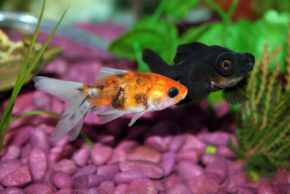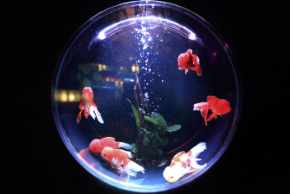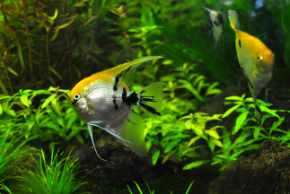How to calculate optimal stocking level? Many fish lovers struggle with the calculation of optimal stocking levels of their aquarium. The optimal stocking level is the number of fish you can put in your aquarium while keeping the water quality at its best levels. The basic rule to calculate optimal stocking level is 1 inch of fish per gallon water. Many fish lovers follow this rule to find out the stocking level of their aquarium. Unfortunately, this rule is extremely inaccurate as it is the weight and volume of the fish that matters, not the length.
It may look very tempting to overcrowd your aquarium with a variety of colorful fish. But in reality, following the “1 fish 1-gallon rule” is extremely risky for aquarium life. Sadly, fishbowls don’t come with stocking charts. So, the fish owners have no idea how many fish they can put in their aquarium.
Luckily, here we have some methods that you can use to calculate the optimal stocking level of your aquarium without suffocating your fish. Plus, we have also discussed what essential factors you need to consider to find out the ideal aquarium stocking levels.
So without further ado, let’s get started.
How to calculate optimal stocking level?
Following are different rules that you can consider to avoid overstocking your tank.
- The 1 inch of fish per gallon rule
This is probably the most commonly used rule for fish tank stocking. Unfortunately, this stocking works with rough estimates. The rule leaves plenty of room for errors and therefore is not a very suitable technique. For example, it does not consider your modern filtration systems, aquarium lighting, living plants, and the type of fish you’d like to have as pets.
Just like humans, every fish has its own size and shape. Stocking a 10-gallon fish tank with pygmy hatchet fish is not the same as stocking your aquarium with full-bodied silver dollars. Larger-bodied fish create more mess and consequently require higher water volumes.
While stocking your aquarium, remember that fishes need some room to swim. They are not going to stay still in the tank. The number of fishes may look perfect on paper, but in reality, the aquarium may be too small for the fish to swim around normally.
Another vital aspect to remember while stocking your tank is the actual size of the fish. Usually, when you bring fish home, it is not fully grown. For example, the cute little Goldfish can reach up to 14 inches in size when it grows up. So always research the actual fish size before stocking your tank.

Trust us, it’s better than dealing with issues later!
Lastly, while stocking a fish tank with this rule, many fish owners assume that the size of the aquarium is equivalent to the gallons of water in it. A 5-gallon fish tank filled with plants, rocks, filters, and declarations does not support 5 gallons of water. The water volume is usually 10-15% less than the actual size of the aquarium.
1 inch of fish per gallon rule may sound reasonable for calculating the optimal stocking level, it has its flaws. To be safer with big body fishes, we recommend 1 inch of fish per 2 gallons of water calculation.
- Surface area rule
This rule is pretty simple. Larger surface areas support greater oxygen exchange. So, the surface area of your fish tank directly impacts how many fishes you can keep in your aquarium.
The surface area rule considers the shape difference between the aquariums to find out the perfect stocking level. This rule finds out the stocking level by multiplying the width times the length of the aquarium. Under this rule, you can stock 1 inch of fish for every 12 square inches of surface area.
Well, this stocking calculation isn’t error-free at all. For instance, it assumes that all fishes are slender-bodied. Which is obviously not true. If you plan to keep wide-bodied fishes in the tank, you have to change the calculation to 1 inch of fish for 20 inches of surface area.
Similar to the one-inch rule, the surface area rule isn’t perfect. Still, you can use this method to stock your fish by making sure that the oxygen exchange is not compromised.
In typical situations, the 1-inch rule works just fine and is relatively easy to calculate. But if you plan to use it to calculate your aquarium’s stocking level, prefer net gallons of water. Also, if the fish tank is not a standard-sized one, the surface area rule can do better.
No matter what optimal calculation method you use, do your research first. It’s better to understock your tank rather than overpopulating it with unhealthy fish.
How to update the standard rules for calculating aquarium stocking levels?

The stocking rules mentioned above are from the 1960s. Both rules don’t consider the modern aquarium filter, which oxygenates the water and processes waste products. Furthermore, the traditional methods don’t say anything about modern food, which produces less waste. Therefore, using such formulas to stock your aquarium today is inappropriate and unrealistic.
To calculate the optimal stocking level of your aquarium, you need to look at the factors that help you to determine how many fish your tank can support. While there are many aspects to consider, the five major factors are;
- The capacity of the aquarium
Firstly, you have to calculate the size of your aquarium to determine how many fish it can support. Fish tanks are usually measured in liters.
You will quickly know the exact size while purchasing one. However, if you don’t know about your aquarium size, here is how you will do it:
- Measure the height, length, and weight of your aquarium in centimeters
- Multiply all three and figure out the volume
- Divide the volume by 1000.
- The result is your aquarium size.
Keep in mind it’s just a rough estimate. The actual aquarium capacity may be less due to decorated objects in the aquarium and glass thickness.
- The water level of the aquarium
The water level of a fish tank is an essential factor that significantly affects your stocking calculations. Fish keepers have to maintain the proper water level to determine how many fishes can survive in it.
If the water levels are shallow, you won’t be able to house as many fishes as an aquarium can support. The ideal water level is 1 inch above the water filter.
Remember. Adding too many objects like shells, rocks, and decoration decreases the water level of your aquarium.
- Types of fish
It may sound strange, but the type of fish you choose also affects your stocking calculation. Everyone has different preferences. Some people like to have lots of small and colorful fish. While others prefer a community of large fish.
Smaller fishes may live peacefully in your standard aquarium, but aggressive ones need more space. So always research the type of fish you want to add to your aquarium before calculating stocking level.
- Oxygen needs of a fish
Depending on the species, the oxygen needs of your fish may vary. For example, narrow-bodied fish don’t need as much oxygen as larger fish requires. However, if you are a fan of bigger fishes, you need to house them in an aquarium that can offer more oxygen and more space.
The oxygen need of a fish significantly affects the stocking level of your aquarium. You can use air stones and good-quality aquarium filters to properly oxygenate the water.
- Filtration level of the aquarium
The filtration level of an aquarium plays a key role in calculating your aquarium stocking levels. Its ability to process waste produced determines how many fishes your aquarium can support. A quality filter must be able to run all the water through it 4 times in an hour. This means that if you have a 20-gallon fish tank, the filter should run 80 gallons of water in an hour.

A filter exceeding this expectation is excellent, but if your filter cannot meet this criterion, it can affect your stocking calculations.
By keeping these factors in mind, you can easily double the stocking levels suggested by the 1-inch fish per gallon and surface area rule. This way, you will get a more realistic calculation of how many fish your aquarium can house.
A good size filter, small fish, proper maintenance, and a modern aquarium can help you stock way more fish. But it is best to be cautious.
Keep in mind it is just a guideline so you can calculate your stocking level a little more accurately. Yet there are a lot more things to consider to get an actual figure calculation, such as:
- Aquarium volume
- Fish weight
- Feeding frequency
- Feeding quantity
- Filter flow rate
- The protein content of food
- Filter media surface area
- Food type
- Filter sponge size
- Fish size
- Chemical filtration type
- Filtration capacity
- Water change amount
- Water change frequency
- Water temperature
- Carbon dioxide fertilization
- Plant coverage
- Plant growth rate
And more!
Why is it important to learn about aquarium stocking levels?

Well, there is a limit to the number of fish you can keep in an aquarium. Fishes, whether big or small, need to have enough space to move around. It is not wise to keep a fish that is 20 cm long in a tank that is only 15 cm wide. Plus, if the fishes are in a community, there should be some space for them to coexist peacefully. Fishes may look harmless, but some of them are territorial and aggressive. Such fishes may fight with each other and can lead to disastrous outcomes.
On the other hand, some fish species produce more waste and pollution. Your average tank filter might not be able to handle so much pollution. As a result, the tank water will be dirty, and the fish may have to deal with some significant health problems. (Not Recommended!)
Most fish like to live in a community. But that doesn’t mean we support overcrowding an aquarium. No. It’s unnatural and, to some extent, unfair to the fish. Overcrowding leads to fin nipping and territorial fights. In some situations, it may cause stress and disease outbreaks which we believe isn’t something you would like to deal with. Or is it?
Therefore, it is vital to learn about aquarium stocking levels to give your pet fish the environment and space they need.
No products found.
Pro tips for stocking your aquarium
- If you plan to have smaller and non-territorial fish, calculating your stocking level by commonly used 1 inch per gallon rule causes no harm.
- If you are calculating the aquarium stocking level with the inch per gallon rule, always consider the net gallons of water, the adult size of fish, its shape, and needs.
- Regardless of any aquarium stocking rule, complete your research about the fish you plan to put in your aquarium.
- It is absolutely fine to stay under the limit. Never stock your aquarium to its full capacity at a time. Make sure you are only adding 25% of fish to the total stocking level.
- If you have a standard internal filter, you can use the guideline of 1cm per liter. But if you have a large external filter capable of processing more waste, our suggested stocking calculations are 1.8 cm per liter.
- Never stock your tank in a single go. Your fish waste is broken down by the colonies of beneficial bacteria. These beneficial bacteria need some time to grow and adjust to the environment and changes. Adding too many fish at once makes it harder for the bacterial colonies to break down the waste.
Wrapping Up
No doubt. Having an aquarium filled with beautiful fishes looks terrific. But overstocking it with so many fish that you can’t even take care of results in only stress-related diseases, miserable aquarium experience, and dead fish.
Keep in mind, there is no fixed number of fish that you can put in your aquarium. You have to consider many factors before you safely calculate the optimal stocking level for your aquarium.
Stocking an aquarium isn’t difficult as long as you complete your research beforehand. Lastly, don’t be so quick to bring fish home. Instead, research, prepare a lovely aquarium and be ready for your amazing pet.
Happy fishkeeping!
Last update on 2023-07-31 / Affiliate links / Images from Amazon Product Advertising API
